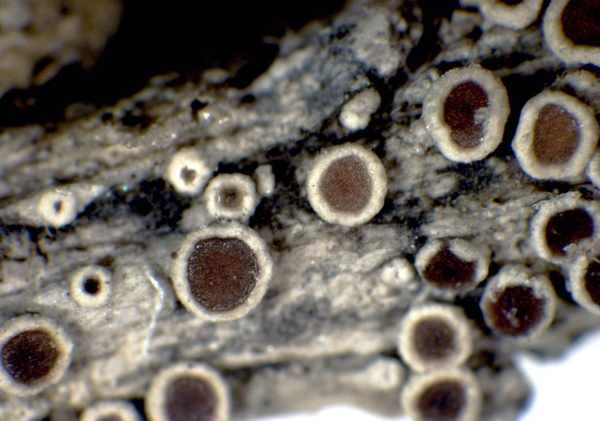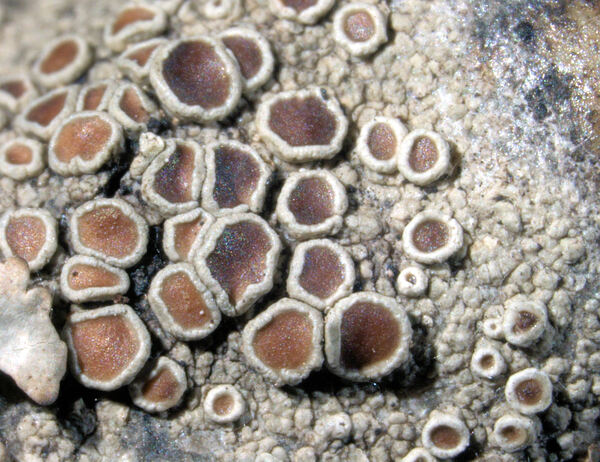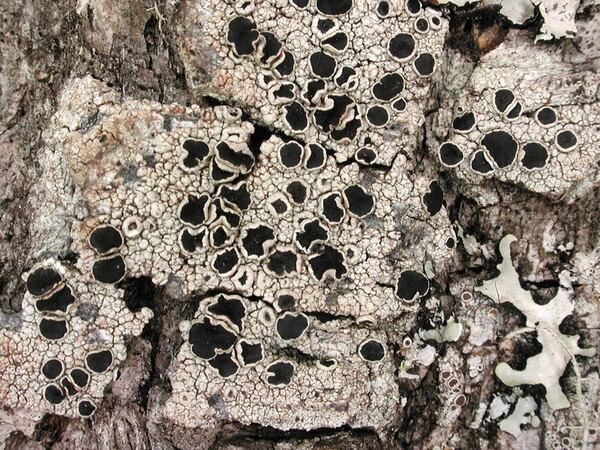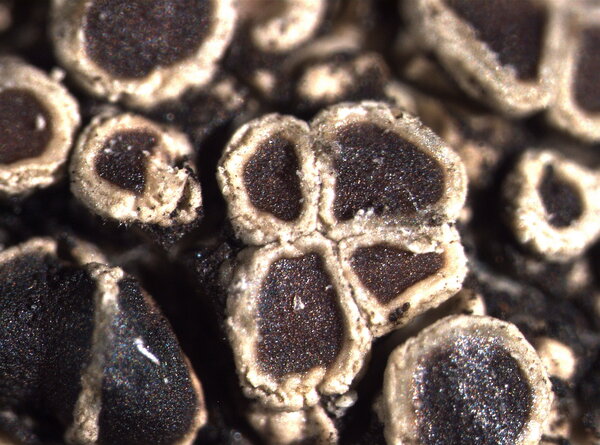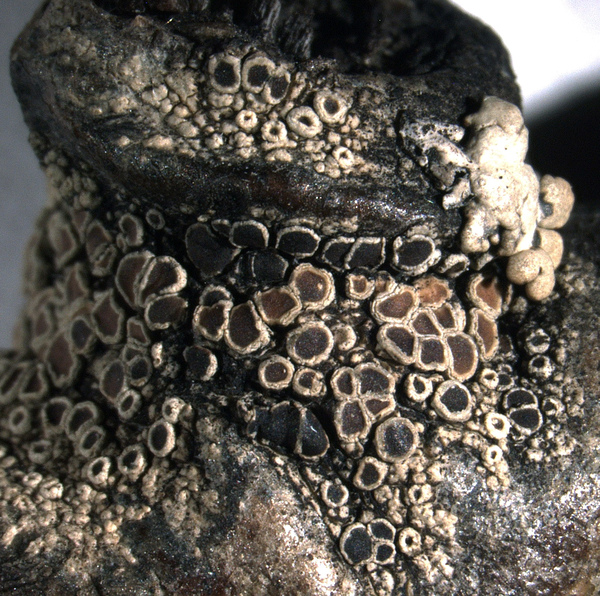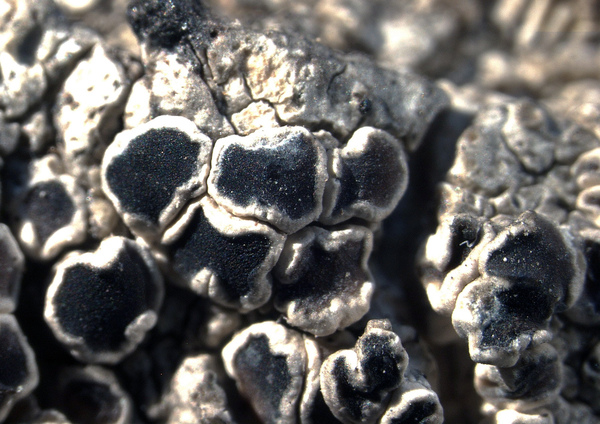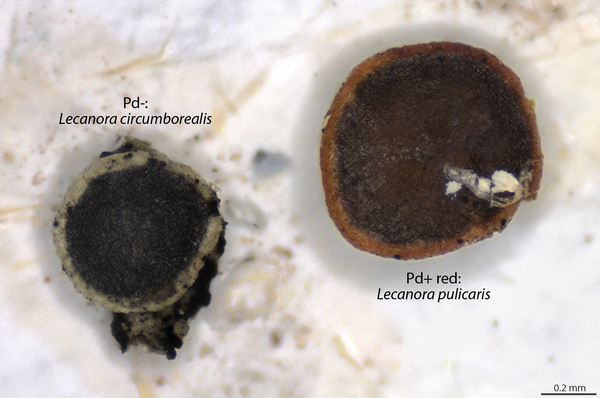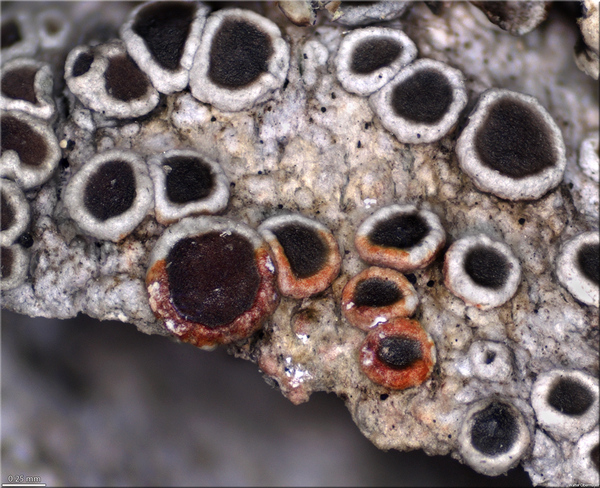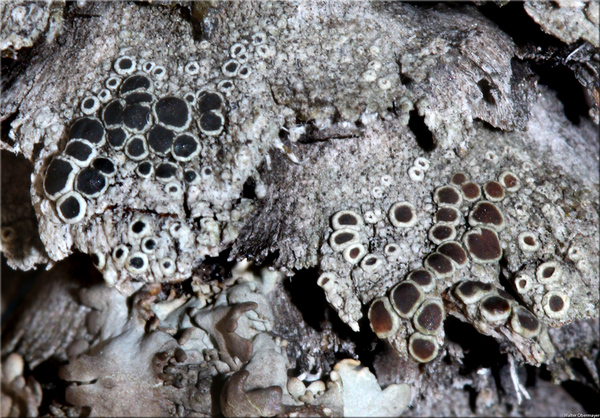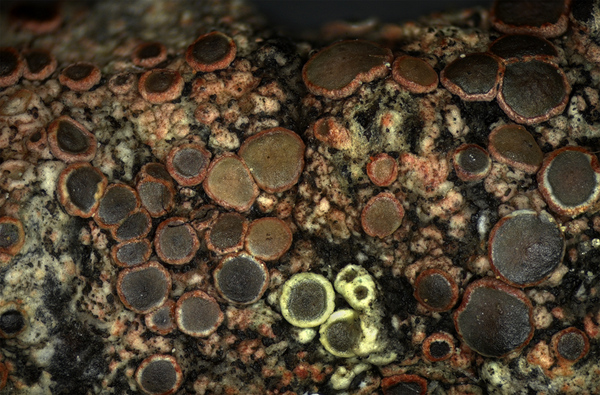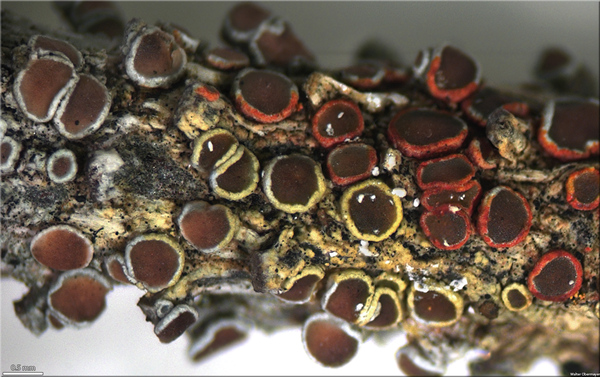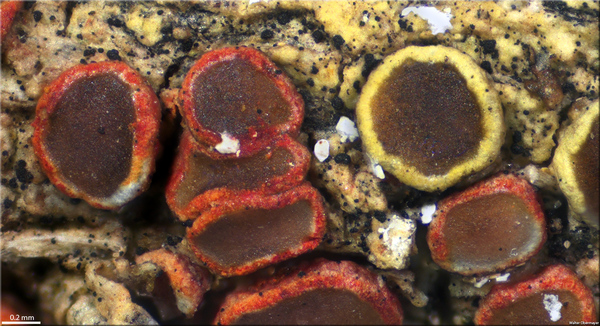Lecanora pulicaris (Pers.) Ach.
Syn. Meth. Lich.: 336, 1814. Basionym: Patellaria pulicaris Pers. - Ann. Wetter. Gesellsch. Ges. Naturk., 2, 1: 13, 1810.
Synonyms: Lecanora chlarona (Ach.) Nyl. non auct. p.p.; Lecanora coilocarpa (Ach.) Nyl. non auct.; Lecanora detrita (Hoffm.) Ach.; Lecanora gangalea auct.; Lecanora pinastri (Schaer.) H. Magn.; Lecanora pulicaris f. pinastri (Schaer.) Clauzade & Cl. Roux; Lecanora subfusca var. detrita (Hoffm.) A. Massal.; Lecanora subfusca var. pinastri Schaer.
Description: Thallus crustose, usually thin and smooth, white to pale grey, sometimes delimited by a dark prothallus. Apothecia lecanorine, sessile or slightly constricted at base, 0.4-1.3 mm across, with a brown to very dark brown (almost black) disc and a smooth, raised thalline margin. Thalline exciple corticate, the cortex (10-)15-20(-25) µm thick laterally, 25-65 µm thick at base, pulicaris-type, the medullary part with abundant, very large crystals which are insoluble in K, often intermixed with small crystals soluble in K (in poorly developed apothecia crystals may be sparse or absent); epithecium reddish brown, with abundant, fine crystals dispersed between paraphyses, which are soluble in K but not in N; hymenium colourless, not inspersed wit oil droplets, 60-90 µm high; paraphyses simple or sparingly branched in upper part, 1.5-2.5 µm thick at mid-level, the apical cells up to 3.5 µm wide; hypothecium colourless. Asci 8-spored, clavate, very thin-walled, with a K/I+ blue, tall tholus penetrated by a faintly amyloid apical cushion, the wall K/I-, surrounded by a blue outer layer, Lecanora-type. Ascospores 1- celled, hyaline, broadly ellipsoid, (10-)11-15(-16) x (6.5-)7.5-10 µm, the wall c. 0.8-1 µm thick. Photobiont chlorococcoid. Spot tests: thallus and apothecial margin K+ yellow, C-, KC-, P+ red, more rarely P+ yellow-orange or P-. Chemistry: atranorin (major), often with variable amounts of fumarprotocetraric or more rarely roccellic acid.
Growth form: Crustose
Photobiont: green algae other than Trentepohlia
Reproductive strategy: mainly sexual
Commonnes-rarity: (info)
Alpine belt: absent
Subalpine belt: rather common
Montane belt: rather common
Dry submediterranean belt: very rare
Humid submediterranean belt: very rare
Padanian area: extremely rare
pH of the substrata:
1 2 3 4 5
Solar irradiation:
1 2 3 4 5
Aridity:
1 2 3 4 5
Eutrophication:
1 2 3 4 5
Poleotolerance:
0 1 2 3
Altitudinal distribution:
1 2 3 4 5 6
Rarity
absent
extremely rare
very rare
rare
rather rare
rather common
common
very common
extremely common
Loading data...
Occurrence data
Predictive map
 Current prediction (1981-2010)
Current prediction (1981-2010)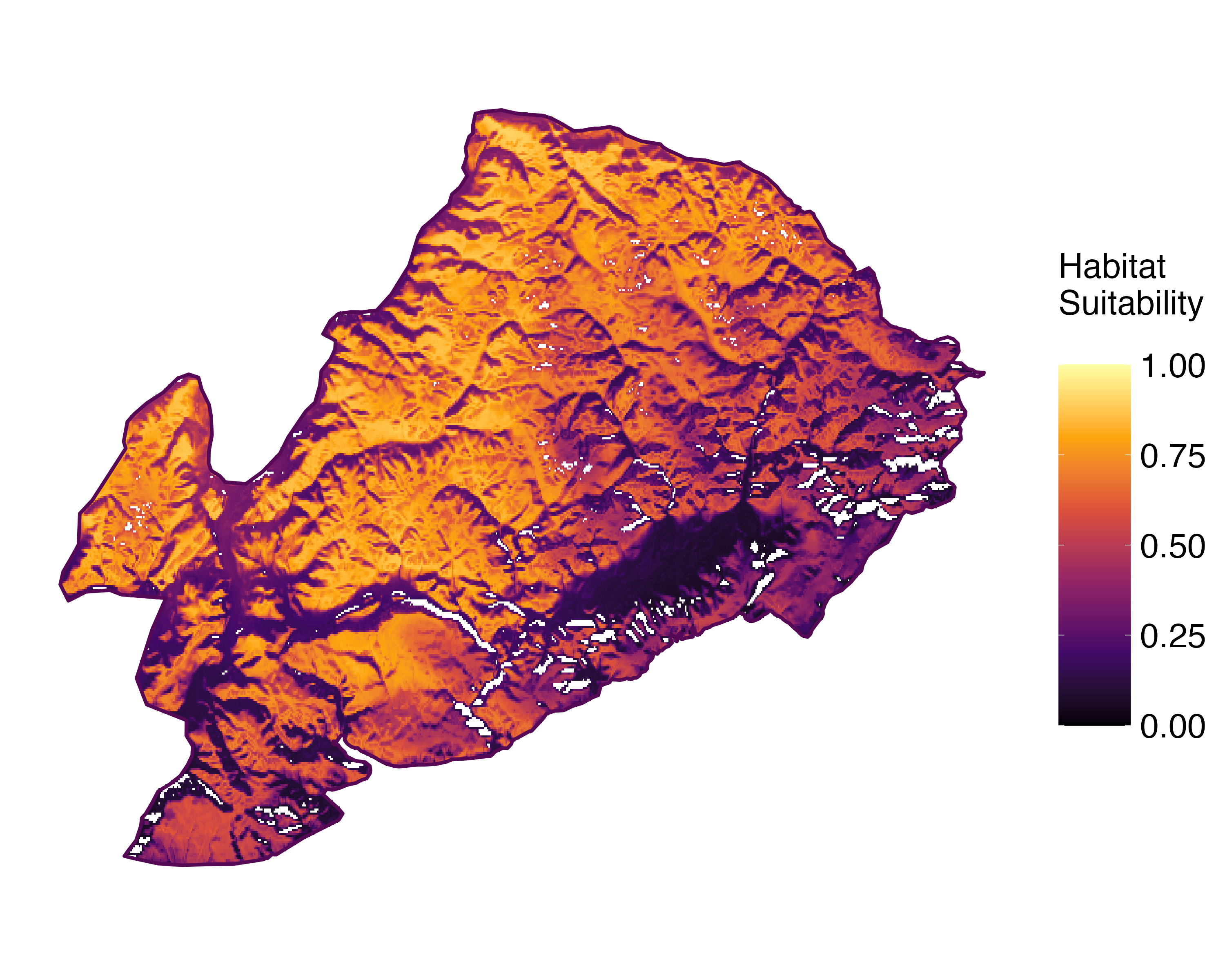 Future prediction (2071-2100) SSP 1-2.6
Future prediction (2071-2100) SSP 1-2.6 Future prediction (2071-2100) SSP 5-8.5Predictive maps according to Francesconi et al. 2025
Future prediction (2071-2100) SSP 5-8.5Predictive maps according to Francesconi et al. 2025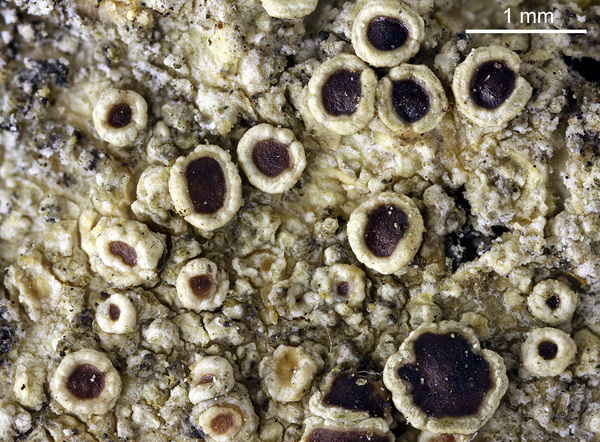
Felix Schumm – CC BY-SA 4.0
[621], Germany, Baden-Württemberg, Kreis Göppingen, Marbachtal bei Zell-Börtlingen. An Laubbäumen in Bachnähe, luftfeucht, lichtoffen, ca. 350 m, TK 7223. Leg. Schumm 7.19.1967, det. J. Poelt.
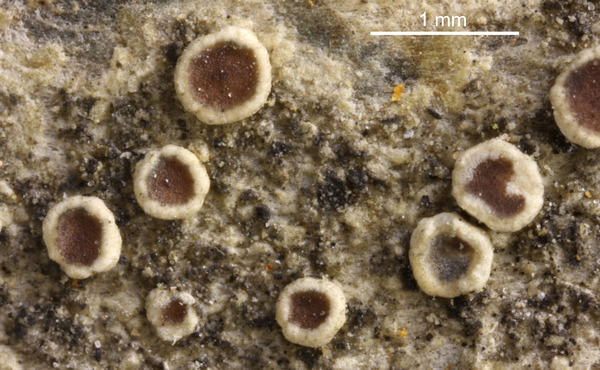
Felix Schumm – CC BY-SA 4.0
[621], Germany, Baden-Württemberg, Kreis Göppingen, Marbachtal bei Zell-Börtlingen. An Laubbäumen in Bachnähe, luftfeucht, lichtoffen, ca. 350 m, TK 7223. Leg. Schumm 7.19.1967, det. J. Poelt.
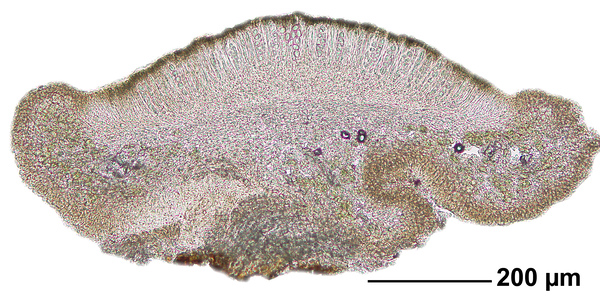
Felix Schumm – CC BY-SA 4.0
[621], Germany, Baden-Württemberg, Kreis Göppingen, Marbachtal bei Zell-Börtlingen. An Laubbäumen in Bachnähe, luftfeucht, lichtoffen, ca. 350 m, TK 7223. Leg. Schumm 7.19.1967, det. J. Poelt.

Felix Schumm – CC BY-SA 4.0
[621], Germany, Baden-Württemberg, Kreis Göppingen, Marbachtal bei Zell-Börtlingen. An Laubbäumen in Bachnähe, luftfeucht, lichtoffen, ca. 350 m, TK 7223. Leg. Schumm 7.19.1967, det. J. Poelt.
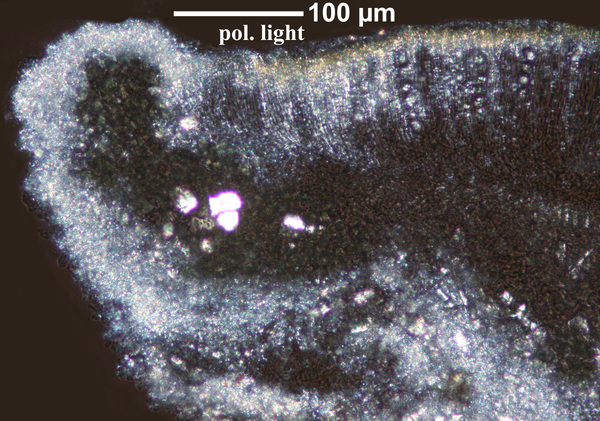
Felix Schumm – CC BY-SA 4.0
[621], Germany, Baden-Württemberg, Kreis Göppingen, Marbachtal bei Zell-Börtlingen. An Laubbäumen in Bachnähe, luftfeucht, lichtoffen, ca. 350 m, TK 7223. Leg. Schumm 7.19.1967, det. J. Poelt.
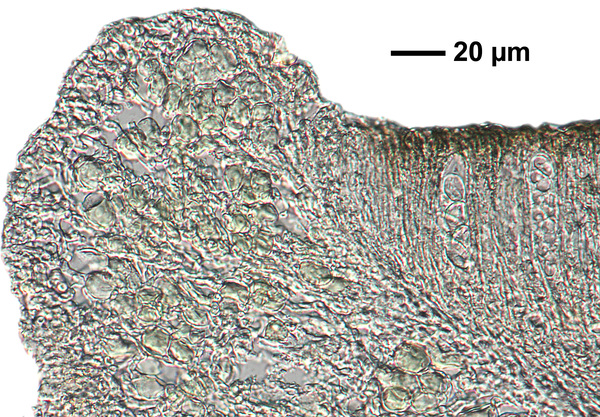
Felix Schumm – CC BY-SA 4.0
[621], Germany, Baden-Württemberg, Kreis Göppingen, Marbachtal bei Zell-Börtlingen. An Laubbäumen in Bachnähe, luftfeucht, lichtoffen, ca. 350 m, TK 7223. Leg. Schumm 7.19.1967, det. J. Poelt.
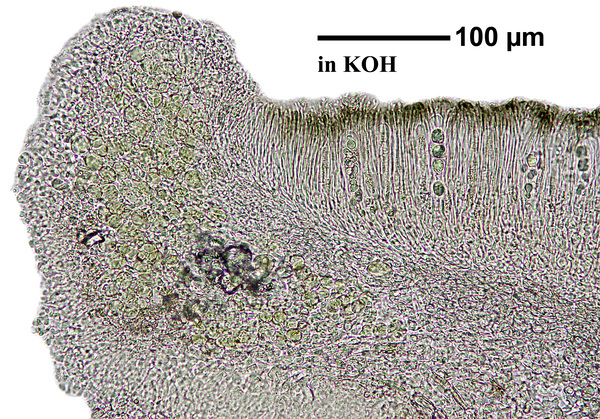
Felix Schumm – CC BY-SA 4.0
[621], Germany, Baden-Württemberg, Kreis Göppingen, Marbachtal bei Zell-Börtlingen. An Laubbäumen in Bachnähe, luftfeucht, lichtoffen, ca. 350 m, TK 7223. Leg. Schumm 7.19.1967, det. J. Poelt.
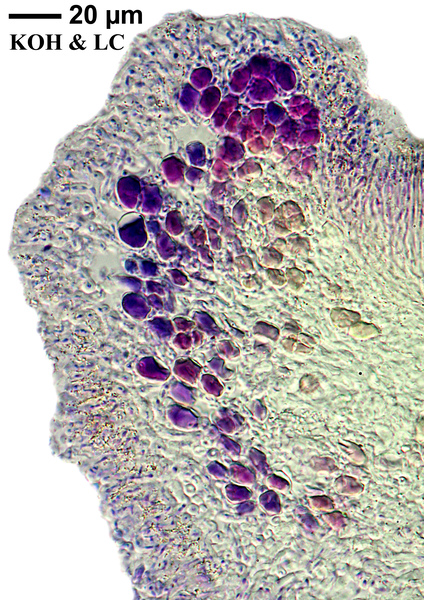
Felix Schumm – CC BY-SA 4.0
[621], Germany, Baden-Württemberg, Kreis Göppingen, Marbachtal bei Zell-Börtlingen. An Laubbäumen in Bachnähe, luftfeucht, lichtoffen, ca. 350 m, TK 7223. Leg. Schumm 7.19.1967, det. J. Poelt.
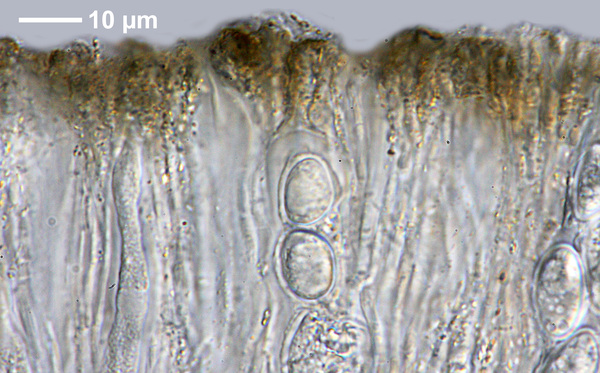
Felix Schumm – CC BY-SA 4.0
[621], Germany, Baden-Württemberg, Kreis Göppingen, Marbachtal bei Zell-Börtlingen. An Laubbäumen in Bachnähe, luftfeucht, lichtoffen, ca. 350 m, TK 7223. Leg. Schumm 7.19.1967, det. J. Poelt.
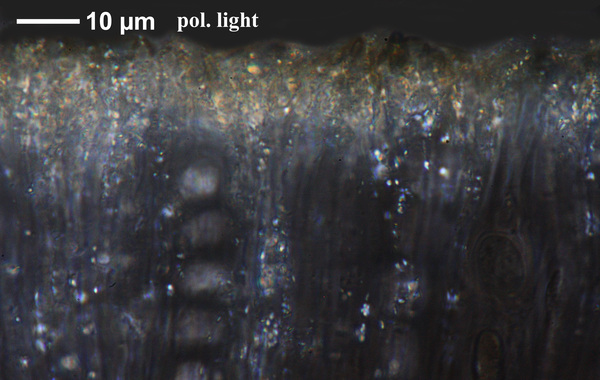
Felix Schumm – CC BY-SA 4.0
[621], Germany, Baden-Württemberg, Kreis Göppingen, Marbachtal bei Zell-Börtlingen. An Laubbäumen in Bachnähe, luftfeucht, lichtoffen, ca. 350 m, TK 7223. Leg. Schumm 7.19.1967, det. J. Poelt.
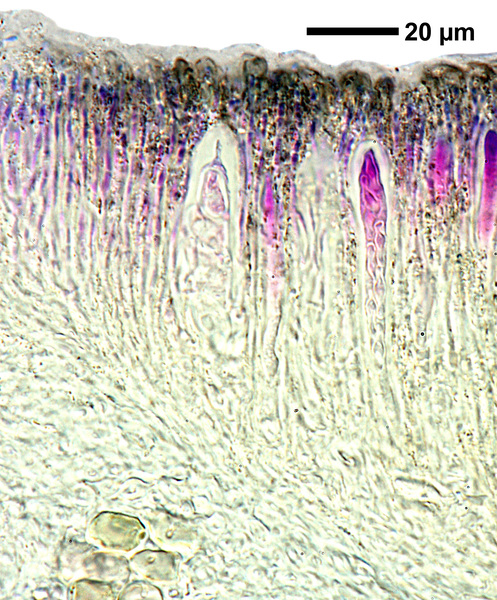
Felix Schumm – CC BY-SA 4.0
[621], Germany, Baden-Württemberg, Kreis Göppingen, Marbachtal bei Zell-Börtlingen. An Laubbäumen in Bachnähe, luftfeucht, lichtoffen, ca. 350 m, TK 7223. Leg. Schumm 7.19.1967, det. J. Poelt.
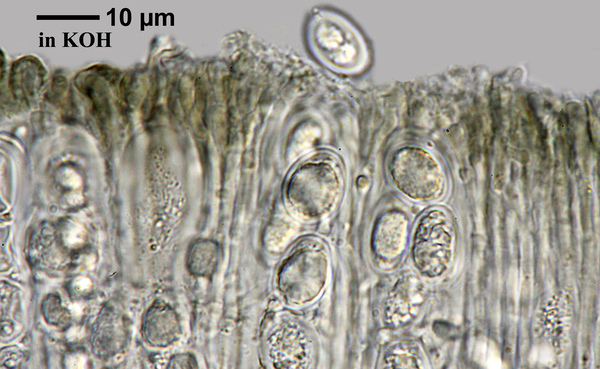
Felix Schumm – CC BY-SA 4.0
[621], Germany, Baden-Württemberg, Kreis Göppingen, Marbachtal bei Zell-Börtlingen. An Laubbäumen in Bachnähe, luftfeucht, lichtoffen, ca. 350 m, TK 7223. Leg. Schumm 7.19.1967, det. J. Poelt.

Felix Schumm – CC BY-SA 4.0
[621], Germany, Baden-Württemberg, Kreis Göppingen, Marbachtal bei Zell-Börtlingen. An Laubbäumen in Bachnähe, luftfeucht, lichtoffen, ca. 350 m, TK 7223. Leg. Schumm 7.19.1967, det. J. Poelt.
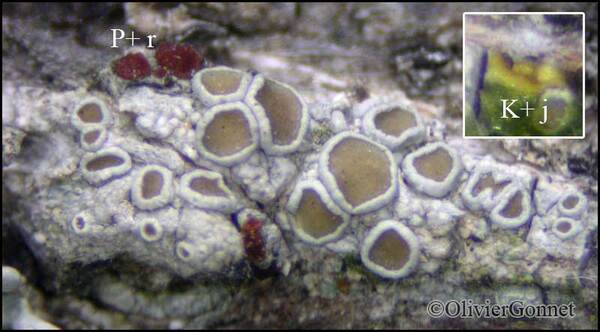
Courtesy Danièle et Olivier Gonnet - Source: https://www.afl-lichenologie.fr/Photos_AFL/Photos_AFL_L/Texte_L_2/Lecanora_pulicaris.htm
France, sur genévrier - 24/02/2012 - Col d'Aiti - Corse
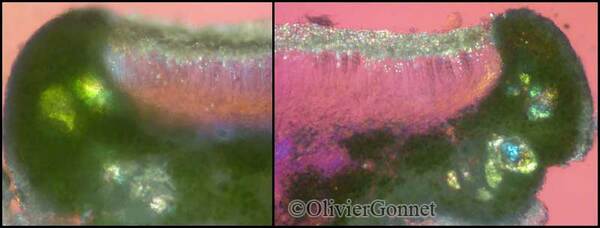
Courtesy Danièle et Olivier Gonnet - Source: https://www.afl-lichenologie.fr/Photos_AFL/Photos_AFL_L/Texte_L_2/Lecanora_pulicaris.htm
France, sur genévrier - 24/02/2012 - Col d'Aiti - Corse
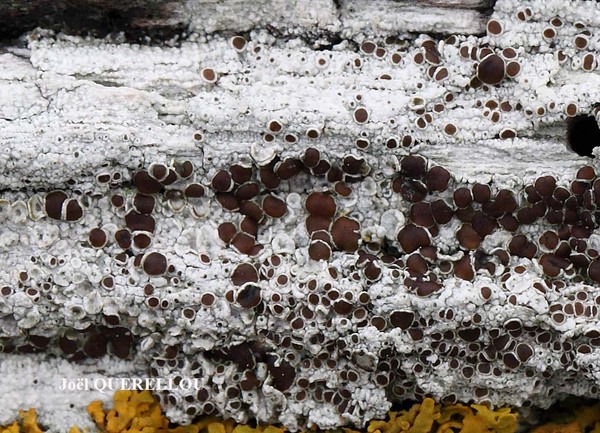
Joël Querellou - Source: http://www.lichensmaritimes.org/index.php?task=fiche&lichen=558&lang=en
France, Le Guilvinec
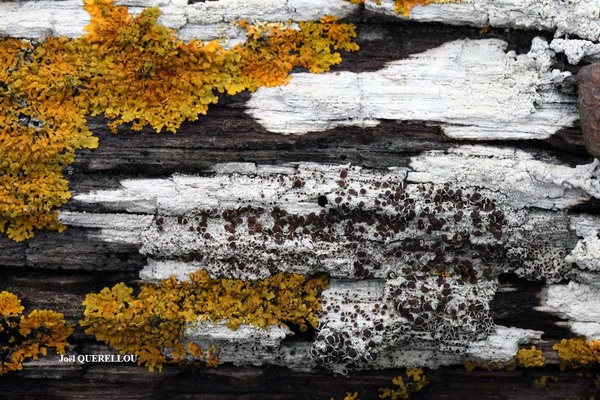
Joël Querellou - Source: http://www.lichensmaritimes.org/index.php?task=fiche&lichen=558&lang=en
France, Le Guilvinec
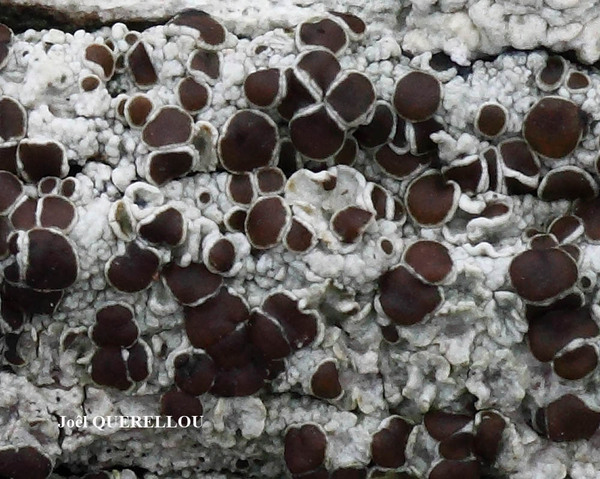
Joël Querellou - Source: http://www.lichensmaritimes.org/index.php?task=fiche&lichen=558&lang=en
France, Le Guilvinec
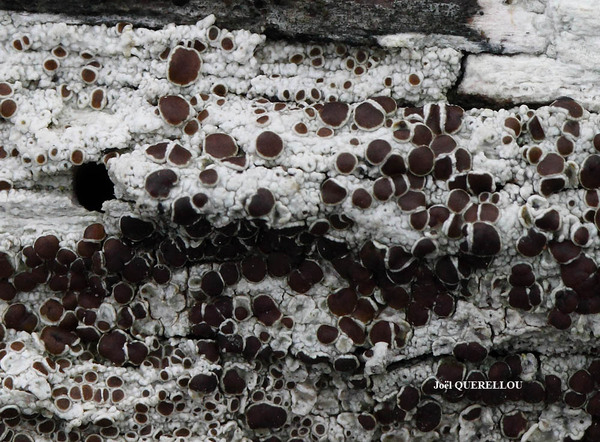
Joël Querellou - Source: http://www.lichensmaritimes.org/index.php?task=fiche&lichen=558&lang=en
France, Le Guilvinec
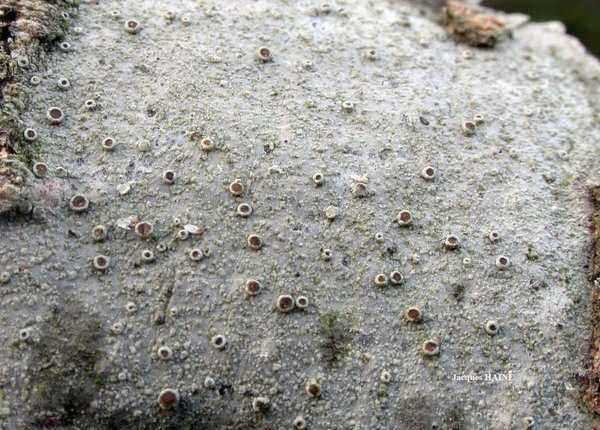
Jacques Haine - Source: http://www.lichensmaritimes.org/index.php?task=fiche&lichen=558&lang=en
France, Ardennes
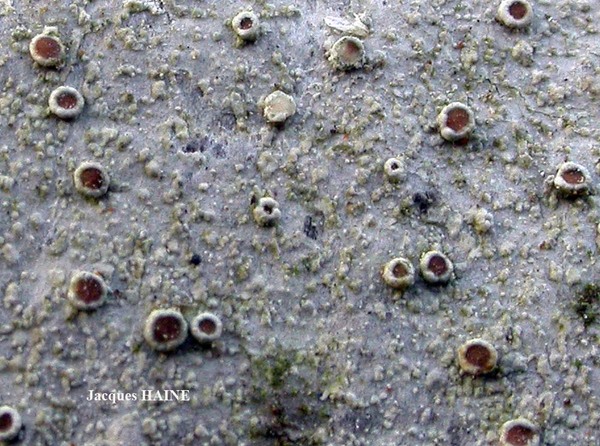
Jacques Haine - Source: http://www.lichensmaritimes.org/index.php?task=fiche&lichen=558&lang=en
France, Ardennes
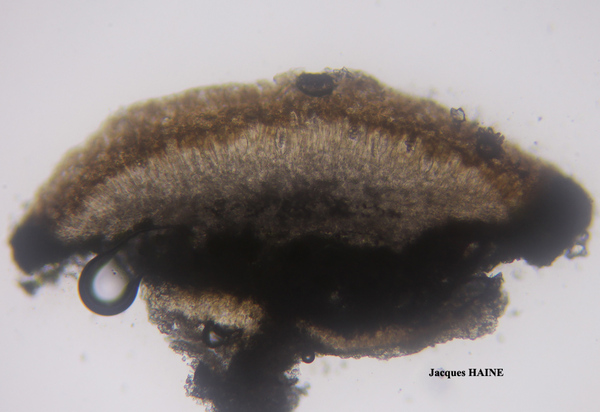
Jacques Haine - Source: http://www.lichensmaritimes.org/index.php?task=fiche&lichen=1044&lang=en
France, Les Bouillouses 2000 m
chemo P-

Jacques Haine - Source: http://www.lichensmaritimes.org/index.php?task=fiche&lichen=1044&lang=en
France, Les Bouillouses 2000 m
chemo P-
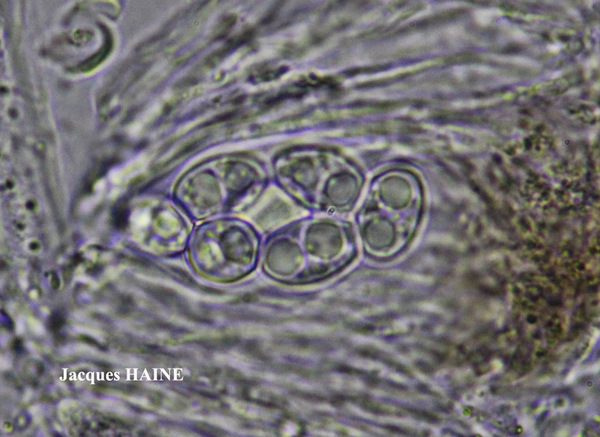
Jacques Haine - Source: http://www.lichensmaritimes.org/index.php?task=fiche&lichen=1044&lang=en
France, Les Bouillouses 2000 m
chemo P-
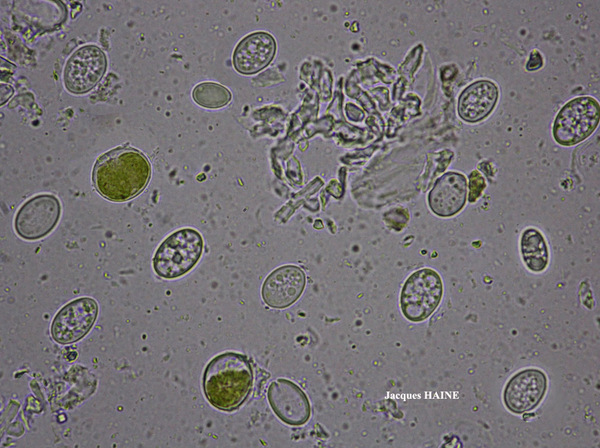
Jacques Haine - Source: http://www.lichensmaritimes.org/index.php?task=fiche&lichen=1044&lang=en
France, Les Bouillouses 2000 m
chemo P-
Growth form: Crustose
Photobiont: green algae other than Trentepohlia
Reproductive strategy: mainly sexual
Commonnes-rarity: (info)
Alpine belt: absent
Subalpine belt: rather common
Montane belt: rather common
Dry submediterranean belt: very rare
Humid submediterranean belt: very rare
Padanian area: extremely rare
pH of the substrata:
| 1 | 2 | 3 | 4 | 5 |
Solar irradiation:
| 1 | 2 | 3 | 4 | 5 |
Aridity:
| 1 | 2 | 3 | 4 | 5 |
Eutrophication:
| 1 | 2 | 3 | 4 | 5 |
Poleotolerance:
| 0 | 1 | 2 | 3 |
Altitudinal distribution:
| 1 | 2 | 3 | 4 | 5 | 6 |
Rarity
absent
extremely rare
very rare
rare
rather rare
rather common
common
very common
extremely common
Loading data...
Occurrence data
Predictive map
 Current prediction (1981-2010)
Current prediction (1981-2010) Future prediction (2071-2100) SSP 1-2.6
Future prediction (2071-2100) SSP 1-2.6 Future prediction (2071-2100) SSP 5-8.5
Future prediction (2071-2100) SSP 5-8.5Predictive maps according to Francesconi et al. 2025

Felix Schumm – CC BY-SA 4.0
[621], Germany, Baden-Württemberg, Kreis Göppingen, Marbachtal bei Zell-Börtlingen. An Laubbäumen in Bachnähe, luftfeucht, lichtoffen, ca. 350 m, TK 7223. Leg. Schumm 7.19.1967, det. J. Poelt.

Felix Schumm – CC BY-SA 4.0
[621], Germany, Baden-Württemberg, Kreis Göppingen, Marbachtal bei Zell-Börtlingen. An Laubbäumen in Bachnähe, luftfeucht, lichtoffen, ca. 350 m, TK 7223. Leg. Schumm 7.19.1967, det. J. Poelt.

Felix Schumm – CC BY-SA 4.0
[621], Germany, Baden-Württemberg, Kreis Göppingen, Marbachtal bei Zell-Börtlingen. An Laubbäumen in Bachnähe, luftfeucht, lichtoffen, ca. 350 m, TK 7223. Leg. Schumm 7.19.1967, det. J. Poelt.

Felix Schumm – CC BY-SA 4.0
[621], Germany, Baden-Württemberg, Kreis Göppingen, Marbachtal bei Zell-Börtlingen. An Laubbäumen in Bachnähe, luftfeucht, lichtoffen, ca. 350 m, TK 7223. Leg. Schumm 7.19.1967, det. J. Poelt.

Felix Schumm – CC BY-SA 4.0
[621], Germany, Baden-Württemberg, Kreis Göppingen, Marbachtal bei Zell-Börtlingen. An Laubbäumen in Bachnähe, luftfeucht, lichtoffen, ca. 350 m, TK 7223. Leg. Schumm 7.19.1967, det. J. Poelt.

Felix Schumm – CC BY-SA 4.0
[621], Germany, Baden-Württemberg, Kreis Göppingen, Marbachtal bei Zell-Börtlingen. An Laubbäumen in Bachnähe, luftfeucht, lichtoffen, ca. 350 m, TK 7223. Leg. Schumm 7.19.1967, det. J. Poelt.

Felix Schumm – CC BY-SA 4.0
[621], Germany, Baden-Württemberg, Kreis Göppingen, Marbachtal bei Zell-Börtlingen. An Laubbäumen in Bachnähe, luftfeucht, lichtoffen, ca. 350 m, TK 7223. Leg. Schumm 7.19.1967, det. J. Poelt.

Felix Schumm – CC BY-SA 4.0
[621], Germany, Baden-Württemberg, Kreis Göppingen, Marbachtal bei Zell-Börtlingen. An Laubbäumen in Bachnähe, luftfeucht, lichtoffen, ca. 350 m, TK 7223. Leg. Schumm 7.19.1967, det. J. Poelt.

Felix Schumm – CC BY-SA 4.0
[621], Germany, Baden-Württemberg, Kreis Göppingen, Marbachtal bei Zell-Börtlingen. An Laubbäumen in Bachnähe, luftfeucht, lichtoffen, ca. 350 m, TK 7223. Leg. Schumm 7.19.1967, det. J. Poelt.

Felix Schumm – CC BY-SA 4.0
[621], Germany, Baden-Württemberg, Kreis Göppingen, Marbachtal bei Zell-Börtlingen. An Laubbäumen in Bachnähe, luftfeucht, lichtoffen, ca. 350 m, TK 7223. Leg. Schumm 7.19.1967, det. J. Poelt.

Felix Schumm – CC BY-SA 4.0
[621], Germany, Baden-Württemberg, Kreis Göppingen, Marbachtal bei Zell-Börtlingen. An Laubbäumen in Bachnähe, luftfeucht, lichtoffen, ca. 350 m, TK 7223. Leg. Schumm 7.19.1967, det. J. Poelt.

Felix Schumm – CC BY-SA 4.0
[621], Germany, Baden-Württemberg, Kreis Göppingen, Marbachtal bei Zell-Börtlingen. An Laubbäumen in Bachnähe, luftfeucht, lichtoffen, ca. 350 m, TK 7223. Leg. Schumm 7.19.1967, det. J. Poelt.

Felix Schumm – CC BY-SA 4.0
[621], Germany, Baden-Württemberg, Kreis Göppingen, Marbachtal bei Zell-Börtlingen. An Laubbäumen in Bachnähe, luftfeucht, lichtoffen, ca. 350 m, TK 7223. Leg. Schumm 7.19.1967, det. J. Poelt.

Courtesy Danièle et Olivier Gonnet - Source: https://www.afl-lichenologie.fr/Photos_AFL/Photos_AFL_L/Texte_L_2/Lecanora_pulicaris.htm
France, sur genévrier - 24/02/2012 - Col d'Aiti - Corse

Courtesy Danièle et Olivier Gonnet - Source: https://www.afl-lichenologie.fr/Photos_AFL/Photos_AFL_L/Texte_L_2/Lecanora_pulicaris.htm
France, sur genévrier - 24/02/2012 - Col d'Aiti - Corse

Joël Querellou - Source: http://www.lichensmaritimes.org/index.php?task=fiche&lichen=558&lang=en
France, Le Guilvinec

Joël Querellou - Source: http://www.lichensmaritimes.org/index.php?task=fiche&lichen=558&lang=en
France, Le Guilvinec

Joël Querellou - Source: http://www.lichensmaritimes.org/index.php?task=fiche&lichen=558&lang=en
France, Le Guilvinec

Joël Querellou - Source: http://www.lichensmaritimes.org/index.php?task=fiche&lichen=558&lang=en
France, Le Guilvinec

Jacques Haine - Source: http://www.lichensmaritimes.org/index.php?task=fiche&lichen=558&lang=en
France, Ardennes

Jacques Haine - Source: http://www.lichensmaritimes.org/index.php?task=fiche&lichen=558&lang=en
France, Ardennes

Jacques Haine - Source: http://www.lichensmaritimes.org/index.php?task=fiche&lichen=1044&lang=en
France, Les Bouillouses 2000 m
chemo P-

Jacques Haine - Source: http://www.lichensmaritimes.org/index.php?task=fiche&lichen=1044&lang=en
France, Les Bouillouses 2000 m
chemo P-

Jacques Haine - Source: http://www.lichensmaritimes.org/index.php?task=fiche&lichen=1044&lang=en
France, Les Bouillouses 2000 m
chemo P-



